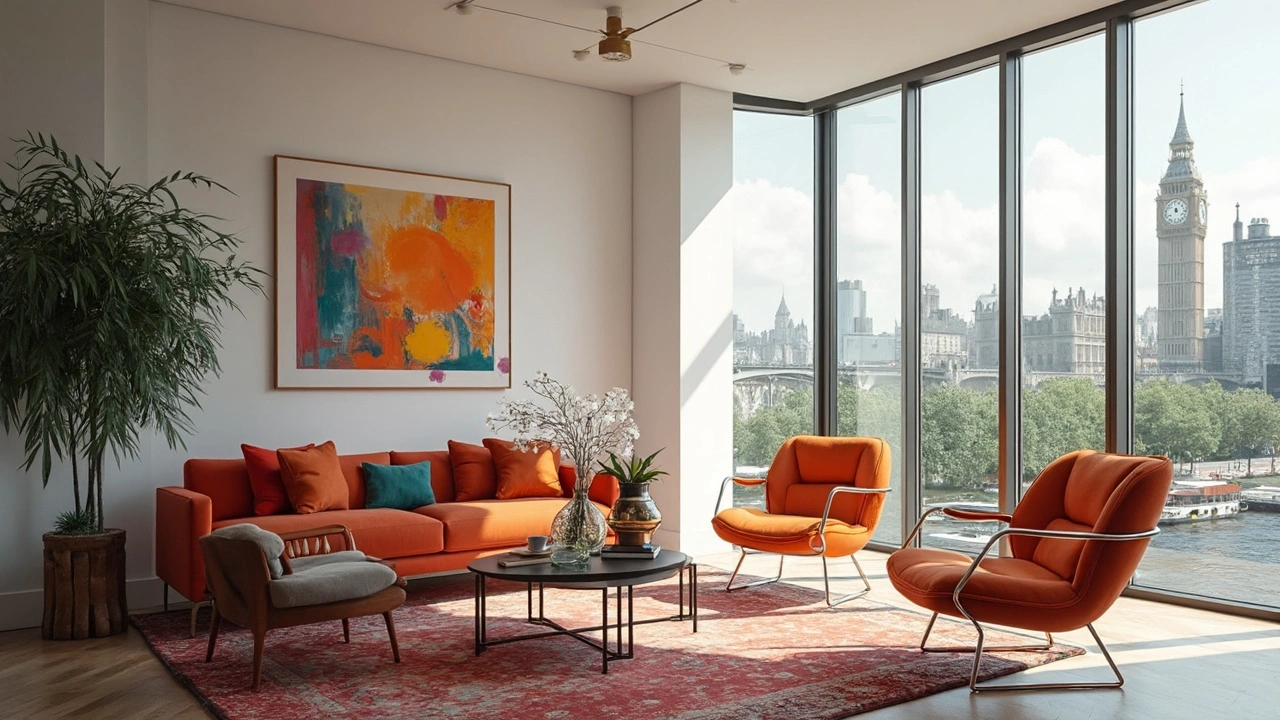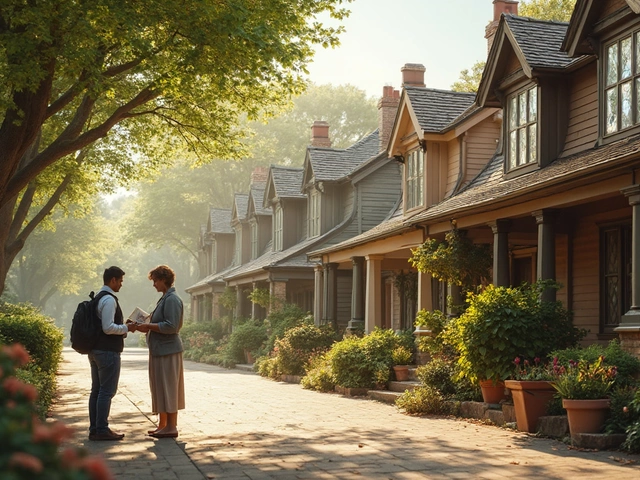Bauhaus style didn’t just give us cool-looking chairs or that lamp you see in every design catalog. It flipped the whole idea of design, making things simpler, smarter, and way more functional. If you’ve ever wondered why your phone feels so easy to use, or why Ikea’s stuff is all clean lines and no fuss—well, you’ve brushed up against Bauhaus thinking.
Instead of fancy decorations or stuffy traditions, Bauhaus was all about what’s useful and honest. No extra fluff. Just forms following function. And that approach wasn’t just for artists or architects—it reached into everyday life. The chair you sit on, the cup you drink from, even city parks and buildings—Bauhaus got its fingerprints on all of it.
- What Made Bauhaus Different?
- From Germany to the World
- Everyday Bauhaus—Furniture and Home
- Tips for Bringing Bauhaus Into Your Space
What Made Bauhaus Different?
When the Bauhaus school started in 1919 Germany, it turned the design world on its head. Instead of teaching people to just decorate stuff, founder Walter Gropius wanted designers and builders to work together. It was this team-up between art, tech, and craftsmanship that set Bauhaus apart. You didn't need to choose between beautiful and practical—you could have both.
Bauhaus wasn't about making something fancy for rich people. It was about creating smart, affordable stuff that anyone could use. Gropius believed mass production wasn't the enemy of good taste, which was a pretty radical thought back then. They ditched the old rules and made things with simple shapes—think circles, triangles, and lines—using new materials like steel, glass, and concrete. That’s why Bauhaus buildings and furniture always look so modern, even now.
The core motto was "form follows function." This meant nothing got added just for show; every curve and angle had a purpose. You see this in the famous Wassily Chair, which looks light, but is super sturdy. Or in Bauhaus buildings, where big windows and open floors made homes brighter and healthier.
Here’s a quick look at what Bauhaus changed compared to the styles before it:
| Before Bauhaus | Bauhaus Style |
|---|---|
| Heavy, ornate furniture | Simple, lightweight design |
| Decorations everywhere | Minimal, clean lines |
| Materials like wood and brass | Glass, steel, concrete |
| Made by hand, costly | Designed for mass production |
The Bauhaus impact was felt right away—students came from all over Europe, the U.S. and even Japan to learn the new way. By 1933, the school was closed by the Nazis, but its teachers and students kept spreading Bauhaus ideas around the world. If you ever build Lego sets with your kids, you’re tapping into a bit of Bauhaus: clean lines, basic shapes, and everything fits together in a simple, smart way.
From Germany to the World
The Bauhaus movement kicked off in 1919 in Weimar, Germany, and for a while it was just a small, radical school with some pretty rebellious ideas about art and design. But political troubles forced the group out of Germany in 1933, and that’s actually when things really got interesting. As the Nazis closed the school, Bauhaus teachers and students spread to places like the United States, Israel, and even South America, carrying their new style with them.
Did you know the famous German architect Walter Gropius, who founded the Bauhaus, ended up at Harvard? He helped start the architecture program there and influenced a ton of American designers. Ludwig Mies van der Rohe, another Bauhaus giant, landed in Chicago and literally shaped the city’s skyline with glass-and-steel buildings.
If you look at postwar buildings in places like Tel Aviv, you'll see rows of white, simple forms that seem almost out of place—these are Bauhaus in action. In fact, Tel Aviv has more than 4,000 Bauhaus buildings; they call it the "White City." The style wasn’t just for big cities or fancy architects. Soon, furniture companies and factories everywhere started turning out products in the Bauhaus look—clean lines, practical shapes, and not a bit of wasted space.
| Country | Key Bauhaus Influence | Notable Landmark |
|---|---|---|
| USA | Modern architecture, interior design | Lake Shore Drive Apartments, Chicago |
| Israel | Urban planning, residential buildings | White City, Tel Aviv |
| Brazil | Furniture design, public art | Copan Building, São Paulo |
This global spread made Bauhaus a household idea without most people even realizing it. Today, when you see flat-pack furniture, big windows, or even tech products with crisp, no-nonsense design, you’re seeing just how far those German roots have reached.

Everyday Bauhaus—Furniture and Home
Let’s talk about what Bauhaus really looks like in your everyday life. You’ll probably spot it first in furniture. Ever seen those sleek tubular steel chairs with simple leather straps? That’s the Wassily Chair, designed by Marcel Breuer in 1925. At the time, it looked wild—like someone took a bike frame and bent it into a seat. But that’s what made it a legend: lightweight, easy to move, sturdy, and the opposite of fussy old sofas.
The Bauhaus crew believed furniture should be affordable and easy for anyone to have at home, not just rich folks. They focused on mass production way before Ikea or Target made it cool. That’s why stacking chairs, folding tables, and modular couches became trendy. Walter Gropius, one of the founders, even designed kitchen cabinets that were super practical—extra storage, simple shapes, and not a fancy bit in sight.
Look at lighting, too. The Wagenfeld Lamp—glass globe on a metal stick, no weird carvings or extra bits—has been around since 1924 and still sells out. The idea was less about showing off, more about giving you what you need. If you walk into a house with lots of open shelving, glossy floors, big windows, and clean, flat surfaces, odds are there’s some Bauhaus DNA in there. People love it because it’s easy to live in and super easy to clean (my daughter Vivienne can spill juice anywhere and it wipes right up; trust me!).
- Bauhaus-style furniture is low to the ground, square, and never bulky or heavy-looking.
- Colors are usually black, white, primary colors (think red, blue, yellow), or natural wood tones.
- Materials are honest—steel, glass, leather, plywood. Nothing fake or covered up.
- Bauhaus homes lean on open-plan spaces, smart storage, and lots of daylight.
If you’re wondering about the best way to bring a little Bauhaus into your own place, start with one piece—a stylish chair, a metal lamp—or even switching up your layout to let light flow better. Sometimes, just getting rid of the clutter can make your space feel way more Bauhaus, and way more modern.
Tips for Bringing Bauhaus Into Your Space
You don’t need a museum budget or a design degree to get that Bauhaus vibe in your own space. It’s actually super approachable, especially if you like things simple, practical, and a little bold. Here’s how you can pull off Bauhaus style at home or even at your office.
- Bauhaus means function first. Before you buy anything, ask: Do I need it? Does it really work for me? If not, skip it. Bauhaus spaces are clutter-free, so adopt a less-is-more mindset.
- Choose furniture with clean lines and simple shapes. Think cube-shaped couches, tubular steel chairs (like the famous Wassily chair by Marcel Breuer), or basic shelving made from wood and metal. No fancy carvings or extra touches—just pure, purposeful form.
- Stick to three main colors: primary red, yellow, and blue. Don’t go overboard, though; one or two pops of bright color among mostly neutral backgrounds (white, gray, black) make a statement the Bauhaus way.
- Mix materials—but keep them honest. Bauhaus design loves things like metal, glass, and natural wood. Don’t try to hide what something is made from; instead, let it show.
- Let in the light. Big windows, open spaces, and practical lighting (think globe lamps or simple floor lamps) all channel classic Bauhaus architecture. It’ll also make your place feel bigger and calmer.
Want a quick cheat sheet for what works? Check this mini comparison table below. The left column shows what to look for; the right, what to avoid if you want to keep it Bauhaus:
| Bauhaus Style | Not Bauhaus |
|---|---|
| Simple, geometric forms | Ornate, decorative carvings |
| Primary colors, clear neutrals | Pastels, earth tones, busy patterns |
| Glass, steel, natural wood | Heavy drapes, plush fabrics, gilded frames |
| Open layout, lots of light | Cluttered rooms, dark corners |
And here’s a fun stat: In a 2023 survey on home design, 43% of respondents said they liked Bauhaus-inspired furniture for how easy it is to match and keep clean. Makes sense—kid messes and random toy explosions (ask my son Jasper!) look less chaotic when the furniture itself is simple and straightforward.
Just remember, you don’t have to go full-on art school. One or two pieces—a lamp, a chair, a rug with bold shapes—can bring that clever Bauhaus feel without overwhelming your space. Try it, and watch your room get cleaner, brighter, and simply smarter.





